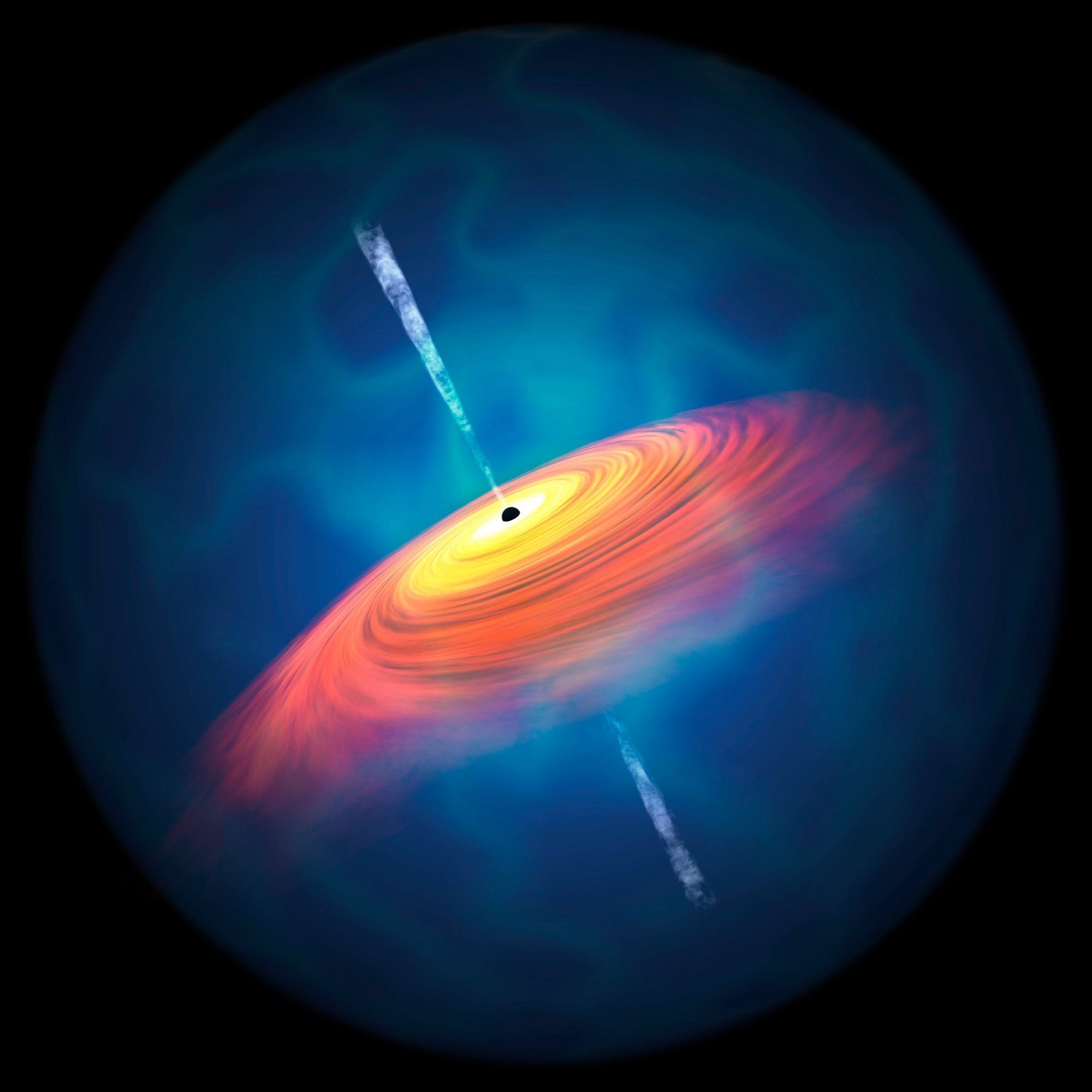Supermassive black holes (SMBHs) are known to exist in the cosmos today. These are black holes with masses greater than a million times that of the Sun. However, it is unknown when and how they evolved throughout the 13.8 billion years of cosmic history. Observations over the last several decades have revealed that every galaxy has an SMBH in its center and that the black hole mass is almost invariably one-thousandth the mass of the host galaxy.

A supermassive black hole (SMBH; the small black dot at the center) absorbs surrounding material, which forms a spiral disk-like shape as it flows in. The gravitational energy of the material is converted to radiation and emitted away from the disk. SMBHs with such shining outskirts are called “quasars.” Image Credit: Yoshiki Matsuoka, Ehime University
This tight association suggests that galaxies and SMBHs co-evolved. The genesis of SMBHs is thus critical not just for understanding SMBHs but also for understanding the creation processes of galaxies, the primary elements of the observable universe.
The early universe, when the time elapsed since the Big Bang (the beginning of the universe) was less than a billion years, holds the answer to addressing this dilemma. It is now possible to gaze back in time by seeing the distant universe, thanks to the limited speed of light.
Did SMBHs exist when the cosmos was only a billion years or less old? Is it feasible for a black hole to gain such a big mass (exceeding a million solar masses and occasionally reaching billions of solar masses) in such a short period of time?
If so, what are the physical mechanisms and circumstances at work? To have a better understanding of the origins of SMBHs, examining them and comparing their attributes to predictions from theoretical models has to be done. And in order to do so, their location in the sky must be determined.
The Subaru Telescope in Maunakea, Hawaii, was employed for the current investigation. Subaru's most significant benefit is its widefield viewing capacity, which is ideal for the scientists’ requirements. They sought “quasars”—SMBHs with bright outskirts where the infalling material releases gravitational energy—because SMBHs do not produce light.
They studied a large area of sky similar to 5000 times the full moon and detected 162 quasars in the early cosmos. Twenty-two of them, in fact, lived when the universe was less than 800 million years old, the most ancient age in which quasars have been discovered so far.
Since there are so many quasars, researchers have been able to establish the “luminosity function,” which characterizes the spatial density of quasars as a function of radiation energy. They discovered that, except for the amplitude, the shape of the luminosity function stayed constant across time, and quasars were generated relatively quickly in the early cosmos.
Strong limitations are placed on theoretical models by the luminosity function’s distinctive behavior, which might ultimately replicate all the observed data and explain how SMBHs came to be.
On the other hand, a significant phase change known as “cosmic reionization” was thought to have occurred during the early stages of the cosmos. Previous research suggests that this explosion ionized the whole intergalactic region.
Radiation from quasars is considered to be a potential option for the source of the ionization energy, which is still up for discussion. Researchers discovered that quasars in the early universe release 1028 photons per second in a unit volume of 1 light-year on a side by integrating the aforementioned luminosity function.
This shows that quasars contributed very little to the reionization of the universe since they amount to less than 1% of the photons required to sustain the ionized condition of intergalactic space at that time. Other energy sources are urgently required, and other recent discoveries suggest that the integrated radiation from massive hot stars in developing galaxies could represent one such source.
Journal Reference
Matsuoka, Y., et al. (2023) Quasar Luminosity Function at z = 7. The Astrophysical Journal Letters. doi:10.3847/2041-8213/acd69f